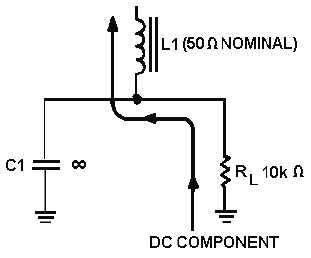4-29
Now let's discuss the dc component of the applied voltage. Remember, a capacitor offers an infinite
(
) impedance to the flow of direct current. The dc component, therefore, must flow through RL and L1.
As far as the dc is concerned, the capacitor does not exist. The coil and the load are therefore in series
with each other. The dc resistance of a filter choke is very low (50 ohms average). Consequently, most of
the dc component is developed across the load and a very small amount of the dc voltage is dropped
across the coil, as shown in figure 4-26.
Figure 4-26.—Dc component in an LC choke-input filter.
As you may have noticed, both the ac and the dc components flow through L1. Because it is
frequency sensitive, the coil provides a large resistance to ac and a small resistance to dc. In other words,
the coil opposes any change in current. This property makes the coil a highly desirable filter component.
Note that the filtering action of the LC choke-input filter is improved when the filter is used in
conjunction with a full-wave rectifier, as shown in figure 4-27. This is due to the decrease in the X
C
of
the filter capacitor and the increase in the XL of the choke. Remember, ripple frequency of a full-wave
rectifier is twice that of a half-wave rectifier. For 60-hertz input, the ripple will be 120 hertz. The XC of
C1 and the XL of L1 are calculated as follows:

